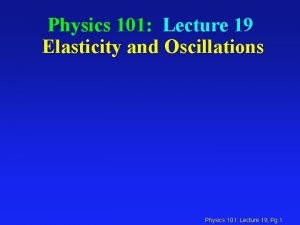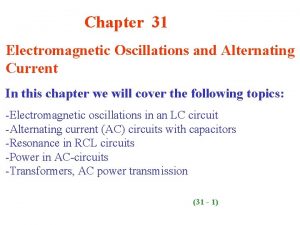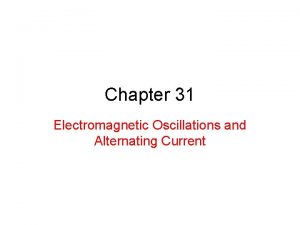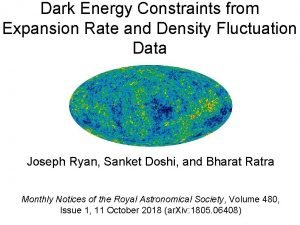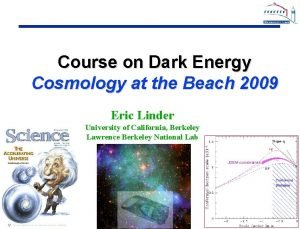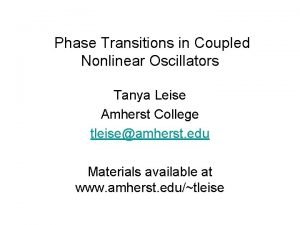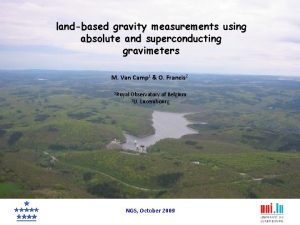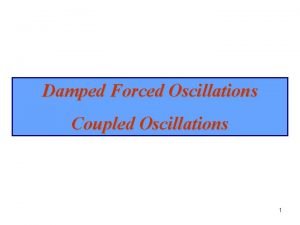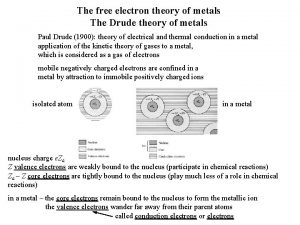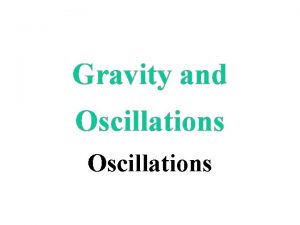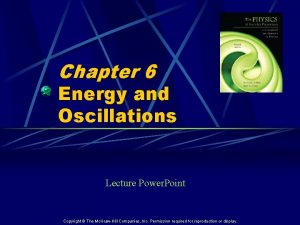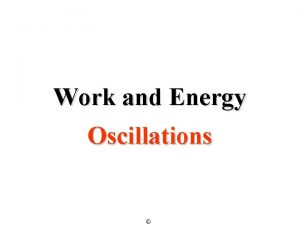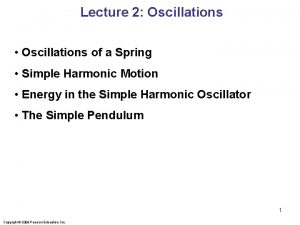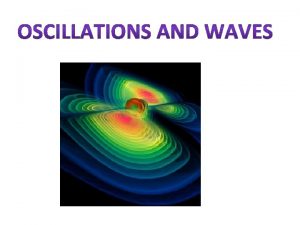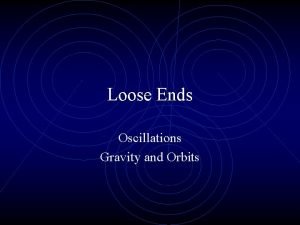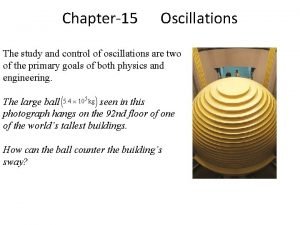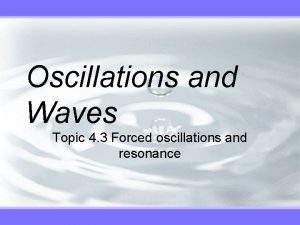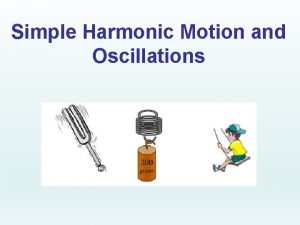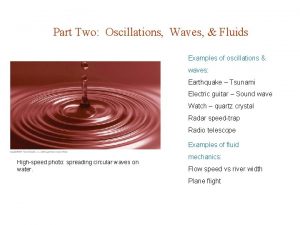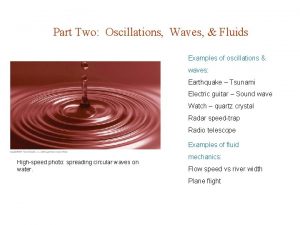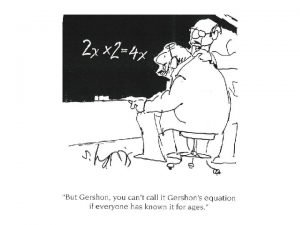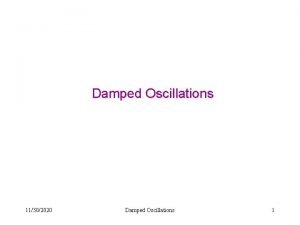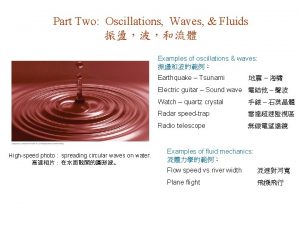Chapter 6 Energy and Oscillations Lecture Power Point































- Slides: 31

Chapter 6 Energy and Oscillations Lecture Power. Point Copyright © The Mc. Graw-Hill Companies, Inc. Permission required for reproduction or display.

Energy and Oscillations Why does a swinging pendant return to the same point after each swing?

Energy and Oscillations The force does work to move the ball. This increases the ball’s energy, affecting its motion.

Simple Machines, Work, and Power v A simple machine multiplies the effect of an applied force. l For example, a lever : §A small force applied to one end delivers a large force to the rock. §The small force acting through a large distance moves the rock a small distance.

Simple Machines, Work, and Power v A simple machine multiplies the effect of an applied force. For example, a pulley : §A small tension applied to one end delivers twice as much tension to lift the box. §The small tension acting through a large distance moves the box a small distance. l

Simple Machines, Work, and Power The mechanical advantage of a simple machine is the ratio of the output force to the input force. For this pulley example, the mechanical advantage is 2.

v Work is equal to the force applied times the distance moved. l l Work = Force x Distance: Work output = Work input W=Fd units: 1 Joule (J) = 1 Nm

v Only forces parallel to the motion do work. v In this case, with the block sliding horizontally, only the 30 N part of the diagonal force does work.

v Power is the rate of doing work l Power = Work divided by Time: P=W/t units: 1 watt (W) = 1 J / s

A string is used to pull a wooden block across the floor without accelerating the block. The string makes an angle to the horizontal. Does the force applied via the string do work on the block? a) b) c) d) Yes, the force F does work. No, the force F does no work. Only part of the force F does work. You can’t tell from this diagram. c) Only the part of the force that is parallel to the distance moved does work on the block. This is the horizontal part of the force F.

If there is a frictional force opposing the motion of the block, does this frictional force do work on the block? a) b) c) d) Yes, the frictional force does work. No, the frictional force does no work. Only part of the frictional force does work. You can’t tell from this diagram. a) Since the frictional force is antiparallel to the distance moved, it does negative work on the block.

Does the normal force of the floor pushing upward on the block do any work? a) b) c) d) Yes, the normal force does work. No, the normal force does no work. Only part of the normal force does work. You can’t tell from this diagram. b) Since the normal force is perpendicular to the distance moved, it does no work on the block.

A force of 50 N is used to drag a crate 4 m across a floor. The force is directed at an angle upward from the crate as shown. What is the work done by the horizontal component a) 120 J of the force? b) c) d) e) 160 J 200 J 280 J 0 J b) The horizontal component of force is 40 N and is in the direction of motion. W=F·d = (40 N) · (4 m) = 160 J.

a) b) c) d) e) What is the work done by the vertical component of the force? 120 J 160 J 200 J 280 J 0 J e) The vertical component of force is 30 N but isn’t in the direction of motion: W=F·d = (30 N) · (0 m) = 0 J.

What is the total work done by the 50 -N force? a) b) c) d) e) 120 J 160 J 200 J 280 J 0 J b) Only the component of force in the direction of motion does work: W=F·d = (40 N) · (4 m) = 160 J.

Kinetic Energy v Kinetic energy is the energy associated with an object’s motion. l l Doing work on an object increases its kinetic energy. Work done = change in kinetic energy

Kinetic Energy v Negative work is the work done by a force acting in a direction opposite to the object’s motion. l l For example, a car skidding to a stop What force is acting to slow the car?

Potential Energy v If work is done but no kinetic energy is gained, we say that the potential energy has increased. l l l For example, if a force is applied to lift a crate, the gravitational potential energy of the crate has increased. The work done is equal to the force (mg) times the distance lifted (height). The gravitational potential energy equals mgh.

Work is done on a large crate to tilt the crate so that it is balanced on one edge, rather than sitting squarely on the floor as it was at first. Has the potential energy of the crate increased? Yes b) No a) a) Yes. The center of the crate has been lifted slightly. If it is released it will fall back and convert the potential energy into kinetic energy.

Potential Energy v The term potential energy implies storing energy to use later for other purposes. l For example, the gravitational potential energy of the crate can be converted to kinetic energy and used for other purposes.

Potential Energy v An elastic force is a force that results from stretching or compressing an object. v Elastic potential energy is the energy gained when work is done to stretch a spring. l The spring constant, k, is a number describing the stiffness of the spring.

Potential Energy v The increase in elastic potential energy is equal to the work done by the average force needed to stretch the spring.

v Conservative forces are forces for which the energy can be completely recovered. l l Gravity and elastic forces are conservative. Friction is not conservative.

Conservation of Energy v Conservation of energy means the total energy (the kinetic plus potential energies) of a system remain constant. l Energy is conserved if there are no nonconservative forces doing work on the system.

A lever is used to lift a rock. Will the work done by the person on the lever be greater than, less than, or equal to the work done by the lever on the rock? a) b) c) d) Greater than Less than Equal to Unable to tell from this diagram c) The work done by the person can never be less than the work done by the lever on the rock. If there are no dissipative forces they will be equal. This is a consequence of the conservation of energy.

Work done in pulling a sled up a hill produces an increase in potential energy of the sled and rider. l This initial energy is converted to kinetic energy as they slide down the hill. l

Any work done by frictional forces is negative. l That work removes mechanical energy from the system. l

A sled and rider with a total mass of 40 kg are perched at the top of the hill shown. Suppose that 2000 J of work is done against friction as the sled travels from the top (at 40 m) to the second hump (at 30 m). Will the sled make it to the top of the second hump if no kinetic energy is given to the sled at the start of its motion? a) b) c) a) yes no It depends. Yes. The difference between the potential energy at the first point and the second point, plus loss to friction is less than the kinetic energy given at the start of the motion.

Springs and Simple Harmonic Motion v Simple harmonic motion occurs when the energy of a system repeatedly changes from potential energy to kinetic energy and back again. v Energy added by doing work to stretch the spring is transformed back and forth between potential energy and kinetic energy.

The horizontal position x of the mass on the spring is plotted against time as the mass moves back and forth. l l l The period T is the time taken for one complete cycle. The frequency f is the number of cycles per unit time. The amplitude is the maximum distance from equilibrium.

v A restoring force is a force that exerts a push or a pull back towards equilibrium. v A restoring force that increases in direct proportion to the distance from equilibrium results in simple harmonic motion.
 Elasticity and oscillations
Elasticity and oscillations Electromagnetic oscillations and alternating current
Electromagnetic oscillations and alternating current Electromagnetic oscillations and alternating current
Electromagnetic oscillations and alternating current Baryon acoustic oscillations
Baryon acoustic oscillations Sustained translatory technique
Sustained translatory technique The universe faster than should be
The universe faster than should be Baryon acoustic oscillations
Baryon acoustic oscillations Baryon acoustic oscillations
Baryon acoustic oscillations Baryonic acoustic oscillations
Baryonic acoustic oscillations Tanya leise amherst
Tanya leise amherst Slow oscillations
Slow oscillations Coupled oscillations
Coupled oscillations Drude theory of metals
Drude theory of metals Plasma oscillations
Plasma oscillations Lotka-volterra predator-prey model
Lotka-volterra predator-prey model 01:640:244 lecture notes - lecture 15: plat, idah, farad
01:640:244 lecture notes - lecture 15: plat, idah, farad Active power reactive power apparent power
Active power reactive power apparent power Power bi power point
Power bi power point Point point power
Point point power Energy energy transfer and general energy analysis
Energy energy transfer and general energy analysis Energy energy transfer and general energy analysis
Energy energy transfer and general energy analysis Power system dynamics and stability lecture notes
Power system dynamics and stability lecture notes Power system dynamics and stability lecture notes
Power system dynamics and stability lecture notes Utilities and energy lectures
Utilities and energy lectures Zline 667-36
Zline 667-36 Power semiconductor devices lecture notes
Power semiconductor devices lecture notes Switch mode power supply lecture notes
Switch mode power supply lecture notes Traditions in things fall apart
Traditions in things fall apart Hub-and-spoke vs point-to-point airlines
Hub-and-spoke vs point-to-point airlines Chapter 7 energy conservation of energy
Chapter 7 energy conservation of energy Solar power satellites and microwave power transmission
Solar power satellites and microwave power transmission Actual power and potential power
Actual power and potential power
